
Stepping up to a challenge
Sylvania woman tackles the Appalachian Trail
4/22/2013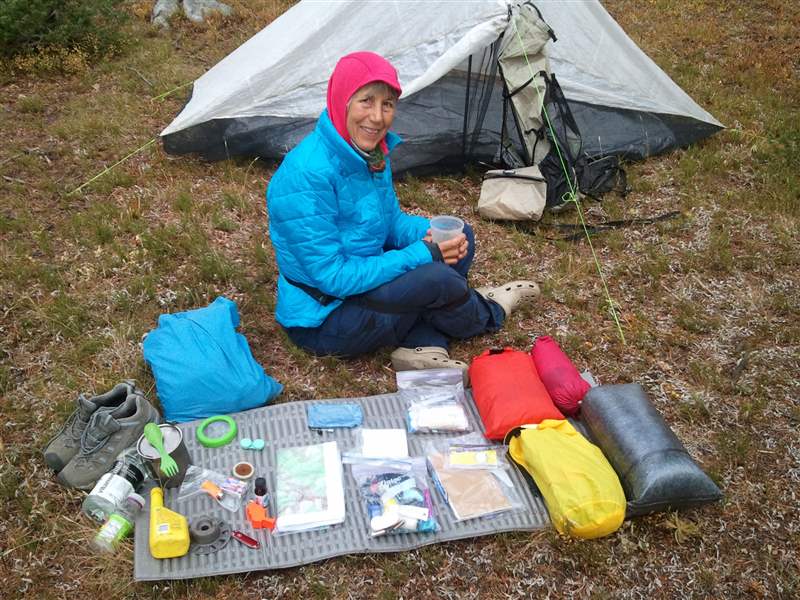
Cheryl McCormick camping in Montana.
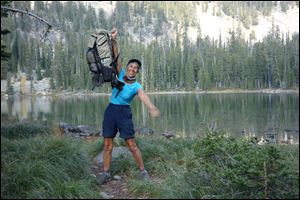
Cheryl McCormick camping in Montana.
To follow Cheryl McCormick’s journey along the Appalachian Trail and to see the gear she packed, check www.trailjournals.com/clinker.
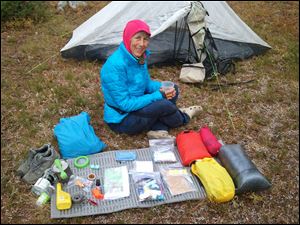
Cheryl McCormick camping in Montana.
Cheryl McCormick understands that a journey of a thousand miles begins with a single step, as does the trek of 2,187 miles she began Friday.
She celebrated her 63rd birthday by hoisting a 24-pound pack on her back and walking onto the Appalachian Trail’s southern-most point at Spring Mountain in northern Georgia. Clinker (her trail name) aims to do a through-trek, arriving at the windswept top of Mount Katahdin, Maine, in October.
“All I know is for 13 years almost every year I’d go on the Appalachian Trail [in the Smoky Mountains] and get excited about people doing it,” Ms. McCormick said last week. From those solo backpacking hikes, she’d return to the Sylvania home she shares with her husband, Dan McCormick, renewed and inspired.
“I’d come back with a sense of pride that I did something that was a little risky, and that carries over in life,” she said in a telephone conversation from Cayo Costa State Park. The McCormicks spend part of the winter tent camping as volunteers on this Florida island, leading hikes, kayaking, and fishing trips.
“I’m a bit of an adventurer and I’m hoping that I can gain some self-mastery skills; keeping my head when things are tough and following what I know my heart desires and not quitting. Being organized so when conditions are difficult or boring I will continue to do what I’ve intended to do.”
‘A real challenge’
At 5-feet, 6-inches tall, she’s added a few pounds to her normal weight of 122 because it’s typical to drop 10 to 12 pounds on the trail. She’s backpacked for decades and spent much of the last year planning. The odds, she knows, are against her. Only 25 percent of those intending to through-hike in one season actually make it, averaging 15 to 20 miles a day. She intends to ramp up her speed gradually.
“It’ll be a real challenge. I have not tested myself on a long hike. My longest has been a six-day trek.” The Appalachian Trail demands more than good legs. “They say it’s 90 percent psychological and 10 percent physical.” To strengthen her mind and spirit, she has learned to practice meditation.
“Physically, I am doing fine. I keep fit doing whatever I like. But the mind, boy, that little puppy runs all over the place.”
Last spring during her annual solo backpacking trip in the Smokies, she was bothered by the weight of pack and changes in elevation. “I took great pains to get my gear weight with four days of food down to 33 pounds.” But it still felt heavy.
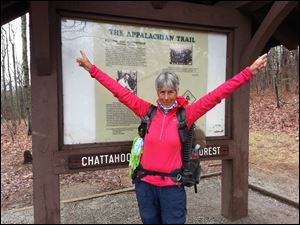
Cheryl McCormick at the starting point of the Appalachian Trail in Springer Moiuntain, Georgia.
Connecting
“I remember when I first started backpacking 43 years ago. I couldn’t find hiking boots for women. The men’s boots were yanking on my bottom half, while my upper half slouched under 45 pounds [in the pack]. But I kept going back to it because it does give you a great sense of wilderness connection in a very simple way. It puts you right there in nature and having to deal with whatever comes along.”
Scrutinizing other hikers, she learned about ultralight backpacking, which includes the lightest, simplest equipment, much of which has a dual purpose. Last fall, she got a scholarship to attend a six-day ultralight trek with a professional guide in Montana during which she tried out her new equipment. In exchange, she’ll produce a DVD demonstrating ultralight’s benefits.
On the Montana hike, she felt well-nourished covering eight to 12 miles a day at elevations of 8,000 to 10,000 feet, higher than what she’ll climb on the Applachian Trail. She learned how to make nutritious vegetarian meals that reconstitute with hot water.
Back home, three friends helped her assemble 65 breakfasts and dinners with combinations of grains, dried milk and cheese, nuts, olive oil, and freeze-dried fruits and veggies. They’ll be mailed to villages along the way and she’ll walk off the trail to collect them every four to six days.
16 lb. pack
Without food, her pack with winter clothes weighs 16 pounds. The waterproof pack is less than a pound; a tent with nine stakes is 13 ounces and uses one of her trekking poles (they relieve pressure on the knees and hips) as its center pole. A down sleeping bag, warm to 20-degrees Fahrenheit, is 20 ounces.
“There’s a dual purpose for everything,” she said. A silk liner for the sleeping bag adds warmth, is easier to wash and dry than the bag, and can be used as a shawl for extra warmth or a wrap when returning from a camp shower. Her kitchen, consisting of a stove, pot, cozy, cup, spork, fuel, and BIC lighter, totals 13 ounces. The stove can use alcohol, wood, or fuel tabs. A small Swiss Army knife has a blade, file, tweezers, scissors, and toothpick. She’ll sleep on a quarter-inch foam pad that she can sit on during meal prep, use for stretches, and roll up into a noodle for swimming.
Her “chair” is a strap she’ll snug around her waist and knees when sitting on the ground. “It’s adjustable and gives my back support when I have nothing else to lean against.”
She’s got two one-liter water bottles, a water purifier, and Crocs for camp shoes. Her ankle-high hiking boots are 26-ounce, waterproof Keen Alamosa which will need replacing along the way. Items are organized into colored bags and zip locks, including 9 ounces of personal hygiene items and a 5-ounce first-aid kit. She’s got a 2-ounce head lamp, a ground cloth that doubles as a poncho, and clothing that’s mostly wool or synthetic.
Clipped to her front shoulder and waist straps are small mesh bags for easy access, holding a small water bottle, whistle, knife, energy bar, pen, notebook, and camera/phone.
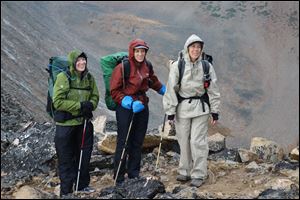
Cheryl McCormick and unidentified companions camping in Montana.
Avoiding ‘creeps’
What scares her are scenarios she stirs up in her mind. She’s experienced nights when black bears circled her tent, breathing heavily and causing the ground to vibrate. She knows they’ll lumber away if she’s hung her food bag from a rope at least 10 feet high and 10 feet from the main trunk of a tree.
“That’s frightening. But the only thing I really need to fear are creeps.” Her plan: if she’s on a section of trail near a road, she’ll hike in a substantial way before pitching her tent “so I don’t have to worry about somebody coming up from the road.”
A former naturalist for the Metroparks of the Toledo Area, Ms. McCormick’s husband and another person will manage her water-garden business while she’s gone. Her sisters will throw a wedding shower for her daughter, and the wedding is scheduled for after Ms. McCormick’s return. Her family will hike with her at one point, as will about eight other groups of friends, most of whom live in the eastern United States.
A vexation has been learning the ins and outs of a new Samsung Galaxy S3 camera/phone. It has two batteries and a dual charger she’ll plug in when she veers off the trail for a laundromat or a night in a campground with a shower or a splurge at a motel.
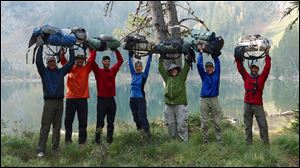
Cheryl McCormick and unidentified campers posting in Montana.
‘Clinker’
She’ll write and post a regular log with photos and short videos, and upon return, she’ll exhibit at the National Center for Nature Photography at Secor Metropark. She’ll also compose 17-syllable poems called haiku, mainly for two friends who are dealing with breast cancer. (“First hint of yellow, she stretches, popping the sun like a vitamin.”)
A trail tradition is for hikers to bestow themselves with a nickname; hers is Clinker, which dates to a math class at Central Catholic High School. She signed a test paper ‘C. Linker’ (her maiden name) and the teacher asked, “Who’s Clinker?” The same teacher nudged her to take advanced math, which intimidated the teen. “But having somebody believe in me, I did it.”
Tucked into her bag is a mascot: a six-inch fabric doll (3 ounces) that belonged to her daughter. It’s trail name: Clinkerbell
McCormick didn’t play organized sports as a kid, but took up running in her twenties. At 49, she discovered a passion for triathlon, completing her first — a 1-mile swim, 25-mile bike, and 6.2-mile run — on her 50th birthday. At 55, she joined a swim team and the coach taught her techniques to help her compete with more ease and less energy.
“Others who make a path for themselves inspire me. I don’t care what it is—a short 5K run, a dance choreographed, a half-ironman, a solo trip, a creative project, a bike tour. You have to make it happen. It won’t just fall in your lap.
“And that’s OK, because there is much to gain in molding that dream, getting it closer to a reality. I guess I would be disappointed if this backpacking trip didn’t happen due to something unexpected ... but I certainly will be more content on my deathbed knowing how hard I tried to make it work.”
Contact Tahree Lane at: tlane@theblade.com or 419-724-6075.